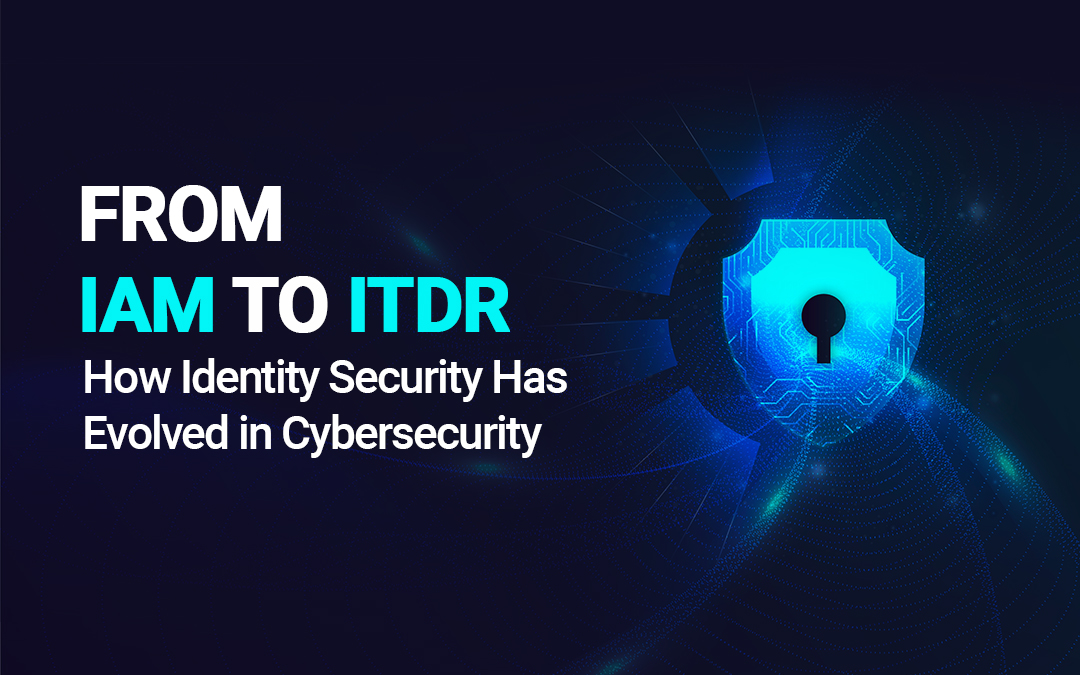
The cybersecurity terrain is growing and so are security tools and strategies to prevent it. Identity security has always been a core piece of cybersecurity, and Identity and Access Management (IAM) systems, traditionally, have been used to manage things like user access and protect sensitive information. However, more advanced identity security solutions are needed as the birth of sophisticated cyber threats. To meet this need, we've seen the emergence of Identity Threat Detection and Response (ITDR) – a proactive alternative to traditional IAM that provides powerful protection from identity-based attacks.
Starting with ITDR explained, we’ll next explore the why of ITDR and the importance of it in today’s cybersecurity landscape. Identity Threat Detection and Response (ITDR) is a security solution that detects, analyses, and responds in real-time to identity‑based threats. Unlike the traditional IAM systems, which are mainly concerned with the distribution of access versus the control, the ITDR system is a bit different. It monitors user behavior and identifies suspicious activity, while response mechanisms help to mitigate threats before they become serious threats. This ensures that even legitimate accounts cannot be misused by malicious actors thus adding to the identity security, which also improves overall cybersecurity resilience in the firm.
Identity and Access Management (IAM): The Foundation
For decades, IAM solutions have assisted organizations in controlling who can access their resources. IAM systems are meant to authenticate users, authorize access and manage identity life cycles. IAM enforces policies and permissions to allow only certain users to access certain applications, files, or systems.
Access control establishes the traditional IAM process. However, traditional IAM is limited to preventing unauthorized access and not the detection or response to potential threats arising from compromised identities. The real-time monitoring and threat detection capabilities required to see abnormal behaviors tied to identity-based attacks, like takeovers or privilege escalations, are often missing from IAMs.
Priviledge escalation and its role in cybersecurity
Escalated privileges are a critical concept in cybersecurity, as they can allow attackers to gain unauthorized control over systems and access sensitive data. Privilege escalation can occur through a variety of techniques, such as exploiting software vulnerabilities, misconfigured permissions, social engineering, or weak passwords. To mitigate the risk of privilege escalation, organizations should apply the principle of least privilege, regularly patch systems, use strong authentication methods, monitor access, and enforce proper configuration management.
Identity-Centric Threats to Watch Out For
Cyber threats have changed over the years and have now moved to target identities. Attackers move away from phishing attacks that attempt to deceive users out of their credentials and focus on gaining control of legitimate accounts as a means to infiltrate systems, putting industrial control systems at great risk.
These cyber threats are identity-centric and hard to recognize since attackers use users or accounts with access rights. After attacks succeed in gaining access, attackers can lateral move within networks, gain privilege escalation, and stay undetected indefinitely.
Traditional IAM proved insufficient to address these bleeding edge threats, necessitating a change of direction towards dynamic and reactive identity security. The attack surface increased as organizations adopted cloud-based solutions and remote work, whose own IAM systems were beginning to lose grip on keeping identities secure.

The Emergence of ITDR
As identity-centric threats continue to rise, ITDR was born. Though it is rooted in IAM, ITDR takes IAM to another level by adding advanced monitoring, analysis, and response capabilities in order to cope with the complex ways identities can be compromised.
ITDR differs from IAM, which typically treats access policies in that it continuously monitors and analyzes identity activity for anomalies. ITDR watches for patterns and can tell when something looks unusual—whether it’s a user logging in from an unusual location, downloading lots of data, or visiting places they shouldn’t be outside of their normal routine. These capabilities enable ITDR systems to notice threats early, sometimes before the attackers themselves know they have been spotted.
Key Features and Benefits of ITDR
1. Real-Time Threat Detection
Next, its ITDR solutions have advanced monitoring tools that can spot and inform the security team of any suspicious activity in real time. Early detection of an attack is critical to stopping an attacker from moving freely between areas within an environment. As identity anomalies are spotted early on, ITDR also becomes capable of responding to potential threats before they can get out of hand.
2. Behavioral Analytics and AI Integrated
ITDR solutions are built with AI and behavioral analytics to establish a baseline of 'normal' user activity. Since every ITDR-based user behavior is always being analyzed to negate any chances of a compromised account, if any key changes are noticed, the user identity is immediately notified. For instance, if a sudden usage of an employee’s account to access sensitive files occurs at times outside their usual working hours, ITDR can mark this as a suspicious activity and trigger an investigation.
3. Automated Response Mechanisms
It’s not enough for ITDR to detect threats; it responds. Certain ITDR systems can take action on the fly when they detect a threat, for example, locking down the compromised account, sending an alert to the security team, or even making the additional step of forcing MFA before allowing access again. An automated response moves fast to mitigate an attack quickly, so there are fewer chances for a data breach.
Modern Cybersecurity Importance of ITDR
The shift from IAM to ITDR reflects a broader trend in cybersecurity: This is part of a move from purely preventive measures to proactive, dynamic defenses that can react to emerging threats. With identities under attack, organizations can’t base data security solely on access control. ITDR is a critical layer of defense, providing the monitoring and response capabilities that are vital to fight back against identity-centric threats and breaches successfully.
Businesses can secure their cloud environments, protect against insider threats, and build resilience against account compromise attacks with ITDR.
Final Notes
In an era of cyber threats on user identity targeting, ITDR affords a proactive and robust solution that can detect and respond in real time to suspicious activities. ITDR is a critical step forward on the long path for organizations looking to improve their security posture in a world that’s digital-first and where the threat landscape only becomes more complex.
Share this post
Leave a comment
All comments are moderated. Spammy and bot submitted comments are deleted. Please submit the comments that are helpful to others, and we'll approve your comments. A comment that includes outbound link will only be approved if the content is relevant to the topic, and has some value to our readers.

Comments (0)
No comment